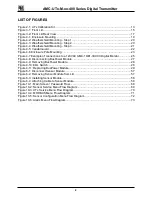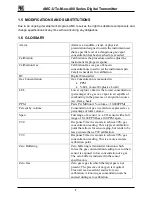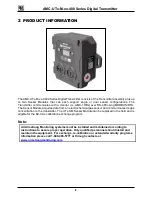
AMC-UTx-M-xx-400 Series Digital Transmitter
7
1.5 MODIFICATIONS AND SUBSTITUTIONS
Due to an ongoing development program, AMC reserves the right to substitute components and
change specifications at any time without incurring any obligations.
1.6 GLOSSARY
Alarm
Alarm is an audible, visual, or physical
presentation designed to warn the instrument user
that a specific level of a dangerous gas/vapor
concentration has been reached or exceeded.
Calibration
Calibration is the procedure used to adjust the
instrument for proper response.
Calibration Gas
Calibration Gas is a gas of known
concentration(s) used to set the instrument span.
Catalytic needs air for calibration.
DT
Digital Transmitter
Gas Concentration
Gas Concentration is measured in:
•
PPM
•
%LEL (Lower Explosive Limit)
LEL
Lower explosive limit is the lowest concentration
(percentage) of a gas or a vapor in air capable of
combusting in the presence of an ignition source
(arc, flame, heat).
PPM
Parts Per Million (1% volume = 10,000PPM)
Percent by volume
Concentration of gas in a mixture expressed as a
percentage of total volume.
Span
Full range of a sensor i.e. a CO sensor with a full
range of 0-100 PPM has a 100 PPM span.
T90
Response Time in seconds to achieve 90% gas
concentration reading. This a typical calibration
point that allows for sensor aging, but tends to be
less accurate than a T99 calibration,
T99
Response Time in seconds to achieve 99% gas
concentration reading. This is a more accurate
calibration point.
Zero Buffering
Zero buffering is transmitter function which
forces the gas concentration reading to zero when
sensor is exposed to low concentration of a gas.
The zero buffer is indicated in the sensor
specification.
Zero Gas
Zero gas is gas in which the target gas is not
present. The presence of oxygen is required.
Clean air is an excellent source for zero
calibration. A known gas concentration can be
entered during zero calibration.








































